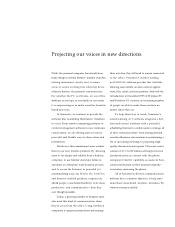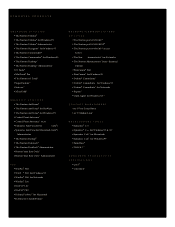Symantec 1996 Annual Report Download - page 21
Download and view the complete annual report
Please find page 21 of the 1996 Symantec annual report below. You can navigate through the pages in the report by either clicking on the pages listed below, or by using the keyword search tool below to find specific information within the annual report.
re venue and earnings from levels expected by securities analysts,
which has had an immediate and significant adverse effect on the
trading price of the Company’s common stock. This may occur
again in the future. Ad d i t i o n a l l y, as a growing percentage of the
Company’s revenues are generated from network software prod-
ucts, which are frequently sold through site licenses that often
occur late in the quarter, the Company may not learn of revenue
shortfalls until late in the fiscal quarter, which could result in an
even more immediate and adverse effect on the trading price of
the Company’s common stock.
Furthermore, the Company participates in a highly dynamic
i n d u s t ry, which often results in significant volatility of the
C o m p a n y’s common stock price. In part i c u l a r, the impact of,
and investors’ assessment of the impact of, the market’s accep-
tance and adoption rate of Mi c ro s o f t’s operating systems,
Wi n d ows 95 and Wi n d ow s N T, on Sy m a n t e c’s business may
result in significant increases in the volatility of Symantec’s stock
price. In addition, the trend towards server-based applications in
n e t w o rks and over the Internet could have a material adve r s e
effect on sales of the Company’s desktop-based products which
may not be offset by sales of the Company’s network - b a s e d
products.
During the last three fiscal years, Symantec has acquired the
following companies:
All of these acquisitions we re accounted for as poolings of
interest. Accordingly, all financial information has been restated
to reflect the combined operations of these companies and
Symantec with the exception of Intec and S L R, which had
results of operations that were not material to Symantec’s con-
solidated financial statements.
Symantec has completed a number of acquisitions and expects
to acquire other companies in the future. While the Company
Ma n a g e m e n t’s Discussion and Analysis of Financial Condition and Results of Op e r a t i o n s
Shares of Acquired
Symantec Company
Common Stock
Stock Options
Companies Acquired Date Acquired Issued Assumed
Delrina Corporation
(“Delrina”) Nov. , ,,*,,
Intec Systems
Corporation (“Intec”) August , , —
Central Point Software,
Inc. (“Central Point”) June , ,, ,
SLR Systems, Inc.
(“SLR”) May , , —
Fifth Generation Systems,
Inc. (“Fifth Generation”) Oct. , ,, —
Contact Software
International, Inc.
(“Contact”) June , ,, ,
*Includes Delrina exchangeable stock that is traded on the Toronto Stock E xchange. Delrina stockholders
received Delrina exchangeable stock in exchange for Delrina common stock at a rate of 0.61 per share.
Delrina exchangeable stock may be converted into Symantec common stock on a one-for-one basis at each
stockholder’s option.
Forward-Looking Statements and
Factors that may Effect Future Results
The following discussion contains forw a rd-looking statements
that are subject to significant risks and uncertainties. There are
several important factors that could cause actual results to differ
materially from historical results and percentages and re s u l t s
anticipated by the forward-looking statements contained in the
following discussion. Such factors and risks include, but are not
limited to, competition in the application and enterprise soft-
ware industry, including price and product feature competition,
the introduction of new products by existing or new competi-
tors, the economic environment, including government and
corporate spending patterns, dependence on distributors and
the emergence of new distribution channels, including the
Internet, consumer acceptance of operating systems and the
positioning of the Company’s products in these markets, the
timing and consumer acceptance of new or upgraded products,
the ability to develop, market, support and acquire new prod-
ucts in an environment of rapidly changing technology and
operating systems and the cost of such activities, acquisition
risks, including increased costs and uncertain benefits and the
ability to effectively integrate operations of acquired companies
and manage growth, seasonality in the retail software market in
Eu rope and risks associated with international operations,
including currency conversion, taxes and other legal re s t r i c t i o n s .
The release and subsequent customer acceptance of current or
upgraded versions of Windows 95 and Windows NT are partic-
ularly important events that increase the uncertainty and will
likely increase the volatility of Symantec’s results over the next
t we l ve months. In addition, the Company operates in a complex
legal environment where, for example, an increasing number of
patents are being issued that are potentially applicable to soft-
w a re, and allegations of patent infringement are becoming
increasingly common in the software industry. Readers should
c a r efully re v i ew the risk factors described in the other docu-
ments the Company files from time to time with the Securities
and Exchange Commission, including the Annual Re p o rt on
Form 10-K as filed by Symantec Corporation on June 26, 1996.
Overview
Symantec develops, markets and supports a diversified line of
application and system software products designed to enhance
individual and workgroup productivity as well as manage net-
w o r ked computing environments. Founded in 1982, the Company
has offices in the United States, Canada, Asia, Australia, Europe
and Latin America.
The Company’s earnings and stock price have been and may
continue to be subject to significant vo l a t i l i t y, particularly on a
q u a rterly basis. Symantec has previously experienced shortfalls in
























